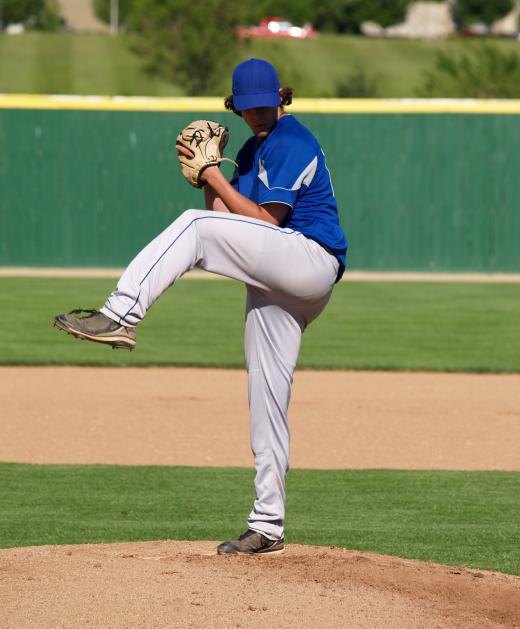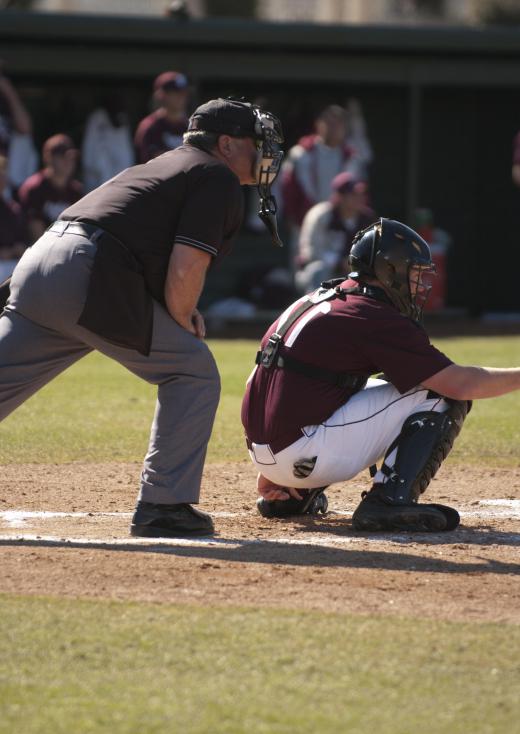The strike zone in baseball is a three-dimensional area that has a width and depth that mirror the shape of home plate and that ranges in height from about the batter's knees up to his or her chest. Different baseball leagues and organizations define the highest and lowest boundaries of the strike zone differently, but they all agree on the width and depth of the zone as well as its purpose and use. If a batter doesn't swing the bat at a pitch and any part of the baseball passed through the strike zone without first hitting the ground, then the umpire will call the pitch a strike; otherwise, it will be called a ball. A strike is beneficial to the pitcher: after three strikes, the batter is out. A ball is beneficial to the batter: after four balls, the batter is allowed to advance to first base.
The Strike Zone's Boundaries

In every set of baseball rules, the left and right sides of the strike zone as well as its depth are determined by the size and shape of home plate, which is a pentagonal slab of rubber. Home plate is 17 inches (43.2 cm) wide and 17 inches (43.2 cm) deep. The sides that are perpendicular to the front edge are half that long, and the final two sides are 12 inches (30.5 cm) long and meet at the back point of home plate. The strike zone essentially is a pentagon-shaped vertical column that has these same dimensions and is always directly over home plate, regardless of where the batter stands.

The top and bottom boundaries of the strike zone can vary among leagues and organizations because the strike zone might be defined a little differently in their rules. For example, the definition of the strike zone in baseball leagues for professional adults might be different from the strike zone in baseball organizations for youths or teenagers. In most professional baseball leagues in North America, including Major League Baseball, the top of the strike zone is halfway between the top of the batter's pants and the top of the batter's shoulders. The highest boundary of the strike zone in baseball leagues for youths, however, is often specified as the batter's armpits. The bottom of the strike zone also can vary slightly, but it generally is the bottom of the kneecap or just below the knee.
Strike Zone Varies from Batter to Batter

The height of the strike zone depends on specific parts of the batter's body, so the zone is larger for a tall batter than for a shorter batter. Most batters crouch just a little when they are in their batting stances, as seen in the photo below, but some batters crouch more, and others stand more upright. In many cases, a batter who stands more upright when batting will have a larger strike zone than a batter who is the same height but whose normal batting stance is more crouched. This is because a batter's upper body will be closer to the knees when he or she is crouched than when he or she is standing upright.

The size of the strike zone also can vary depending on when the batter's strike zone is determined. In some leagues and organizations, including Major League Baseball, the batter's strike zone is determined by his or her stance when he or she is ready to swing at a pitch. Other sets of rules specify that it is determined by the batter's stance when he or she is swinging at a pitch. Some sets of rules even indicate that a batter cannot make his or her strike zone smaller by crouching or leaning over more, and that the strike zone should be determined by what would be a normal batting stance.
Tough Task for Umpires

An umpire's job of calling balls and strikes is not easy. When a pitcher throws a pitch, it typically takes 0.4 to 0.6 seconds before it reaches home plate. This is true even in youth baseball, where the pitchers are unable to throw the baseball as fast as older players but where the pitching rubber — where the pitcher must stand to throw a pitch — is closer to home plate than in leagues for older players. The time that it takes for the baseball to actually pass through the strike zone is less than 0.02 seconds and can be less than 0.01 seconds for the hardest-throwing professional pitchers. When the pitch is sinking, curving or seeming to flutter as it moves and especially when it is near the edge of the strike zone, the umpire must be highly skilled to accurately determine whether it is a strike or a ball.
The calling of balls and strikes is often a source of dispute between the umpire and players or coaches. One reason why there is often disagreement is because the only person who sees the pitch from essentially the same angle as the umpire is the catcher, who squats behind home plate with the umpire crouching behind him or her. Other players on the field and the players and coaches who are in the dugout areas on the sides of the field are farther away from the strike zone and see the pitch from different angles. Therefore, they might see the catcher catch a pitch with his or her mitt near the ground or to the left or right of home plate and believe that it should have been called a ball, while the umpire might have called it a strike after seeing that the baseball actually did pass through the strike zone as it crossed the plate.
An umpire must use his or her best judgment to call balls and strikes. Some umpires tend to be more lenient and might call strikes that are near the edge of home plate, even if part of the baseball does not cross over it, and others tend to be more strict and won't call a strike if only a little bit of the baseball passes over the edge of the plate. Umpires also can vary in their tendencies to call strikes near the top or bottom of the zone.
It can help a pitcher or batter to know the umpire's tendencies. A pitcher can benefit by focusing more on pitching to areas where the umpire tends to be more lenient about calling strikes. Likewise, a batter can benefit by not swinging at pitches in areas where the umpire is less likely to call a strike.
Pitching to the Strike Zone
Skilled pitchers will try to have as little of the baseball pass through the strike zone as possible. This is because a pitch that is in the middle of the zone usually is easier for a batter to hit. Most professional pitchers are able to throw pitches into the strike zone more than 90 percent of the time while practicing. During games, however, when pitchers usually are trying to keep the batters from hitting the baseball well, about half to two-thirds of all pitches typically are in the strike zone.
Pitchers also sometimes intentionally throw pitches that are not in the strike zone, usually in an effort to get the batter to swing and miss. When the batter takes at least a half-swing and misses, the pitch is called a strike. Another type of strike is when the baseball is hit into foul territory — the area outside the lines that designate the field of play — and is not caught in the air. This is called a foul ball, and it counts as a strike when there are fewer than two strikes on the batter or if the batter attempts to bunt — or tap the baseball with the bat instead of swinging at it — when there are two strikes.
Video Technology and the Strike Zone
Some professional leagues use video and computer technology to judge umpires on their ability to call balls and strikes accurately. This is to help umpires improve their accuracy through a performance review process as well as to determine which umpires are the most accurate and should be assigned to the most important games, such as a championship game or series. Although technology exists that would permit balls and strikes to be called accurately by a computer, as of 2011, there were no baseball leagues that were known to use this technology during games.
